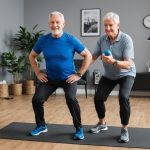Benefits of Resistance Band Workouts for Seniors
Resistance bands offer a multitude of advantages for those focusing on senior fitness, particularly in enhancing muscle strength. These simple, elastic bands provide variable resistance, allowing seniors to perform exercises at their own pace and comfort level. This adaptability is crucial for maintaining and building strength without overburdening the joints—a common concern among seniors.
The benefits of exercise with resistance bands extend beyond just muscle improvement. Regular use can lead to better joint mobility, increased flexibility, and enhanced balance. This collectively contributes to a reduced risk of falls, which is a significant health concern for seniors. Furthermore, these workouts promote cardiovascular health, aiding overall well-being.
Additional reading : Empowering Seniors: Harnessing Guided Meditation for Effective Anxiety Relief
One of the standout features of resistance bands is their accessibility and portability. Unlike bulky gym equipment, these bands can be easily stored and transported, making them an ideal workout companion for seniors. Whether at home or while traveling, engaging in regular resistance band exercises is convenient and cost-effective, eliminating barriers often encountered with traditional fitness regimes.
Incorporating resistance bands into a routine can substantially improve the quality of life for seniors, supporting both physical and mental health. It’s a simple yet potent tool for healthy aging.
In parallel : Essential Gentle Stretching Techniques for Seniors Over 70: Boosting Flexibility and Well-being
Safe and Effective Resistance Band Exercises
Resistance bands offer a versatile and portable way to enhance your strength training routine. However, to ensure your workout is both safe and effective, it’s vital to incorporate important injury prevention strategies.
Start by inspecting your bands for any signs of wear or damage, as this can prevent unexpected snaps. Also, always maintain a firm grip and secure footing to reduce slipping. Remember to perform each exercise in a controlled manner to maximise the benefits of the resistance band routines while minimising risk.
Basic exercises to incorporate include bicep curls, side leg lifts, and seated rows. For each, attach the band to a stable anchor or step on it firmly. Ensure your movements are slow, focusing on form rather than speed. This helps effectively engage the targeted muscles while preventing strain.
Modifications for varying fitness levels are key. Beginners can start with lighter resistance bands and shorter repetitions, gradually increasing both as strength improves. More advanced users might incorporate heavier bands or combine exercises for a dynamic, full-body workout. Always listen to your body, adjusting the intensity as needed to stay safe and prevent overexertion.
Step-by-Step Workout Routine for Seniors
Incorporating a senior workout routine into daily life can greatly enhance flexibility, balance, and overall well-being for seniors. Understanding the structure of these exercises ensures safe and effective workouts.
Warm-Up Exercises
Beginning with a warm-up is crucial for preparing the body, as it increases blood flow to muscles and reduces the risk of injury. Simple activities such as walking, arm circles, and gentle leg swings are ideal. These movements gradually elevate heart rate and ready the joints for the tasks ahead.
Main Workout Routine
The structured workouts emphasize exercises adapted to seniors’ abilities, with a focus on resistance band exercises. For instance, seated row or leg press with bands effectively targets multiple muscle groups. Typically, aim to complete 8-12 repetitions per set for each exercise, with a recommendation of 2-3 sets, allowing adequate rest in between. This balance maintains strength without overstressing the body.
Cool Down and Recovery
After completing the workout, a cooling down phase is imperative. It aids in reducing muscle stiffness and enhances recovery. Incorporating stretches like calf stretches, neck rolls, and shoulder stretches can significantly ease muscle tension. These movements assist in bringing the heart rate back to resting levels gradually, facilitating an overall sense of relaxation.
Variations for Different Fitness Levels
When embarking on a fitness journey, it’s vital to tailor your workouts to your skill level. Beginner workouts are designed to ease you into a routine, ensuring you build a strong foundation. An introductory session might incorporate basic resistance band exercises focusing on form and control.
As you become more comfortable, progressing to advanced resistance band exercises can yield significant improvements. These workouts increase in intensity and complexity, challenging your body in new ways. Advanced variations often include multi-muscle exercises and increased resistance for enhanced strength and endurance.
Fitness progression should be gradual. By methodically increasing difficulty, you avoid overexertion and reduce the risk of injury. It’s crucial to listen to your body’s signals—pain or discomfort implies a need to reassess the exercise routine. Transitioning from beginner to advanced workouts requires patience and consistency to ensure sustainable development.
Ultimately, adjusting your workout routine to your fitness level is about acknowledging your body’s needs and capabilities. Engage with your progression; this will not only enhance your physical well-being but also maintain motivation and enjoyment in your exercise regimen.
Tracking Progress and Resources
In the journey to improve senior health, tracking fitness progress is crucial. Not only does it provide motivation, but it also helps in evaluating one’s strength gains over time. Imagine a scenario where you’re gradually increasing the resistance of your bands. By documenting these changes, you can visually see how much stronger you’ve become. For seniors, leveraging fitness tracking tools can significantly enhance this experience.
Fitness trackers, whether apps or wearable devices, can monitor a variety of health metrics like heart rate and calories burned. These progress evaluation tools offer a way to set achievable goals and ensure that you’re on the right path. Furthermore, they can send reminders to keep you consistent in your routine.
When it comes to additional resources, there is a plethora of communities and support systems tailored for seniors embracing resistance bands. Online forums and local clubs offer peer support and expert advice, further encouraging a healthier lifestyle. By surrounding oneself with these communities, seniors can gain insights and share experiences, making their fitness journey not just productive but also enjoyable.
Remember, the goal is to enhance both physical well-being and social connections.











